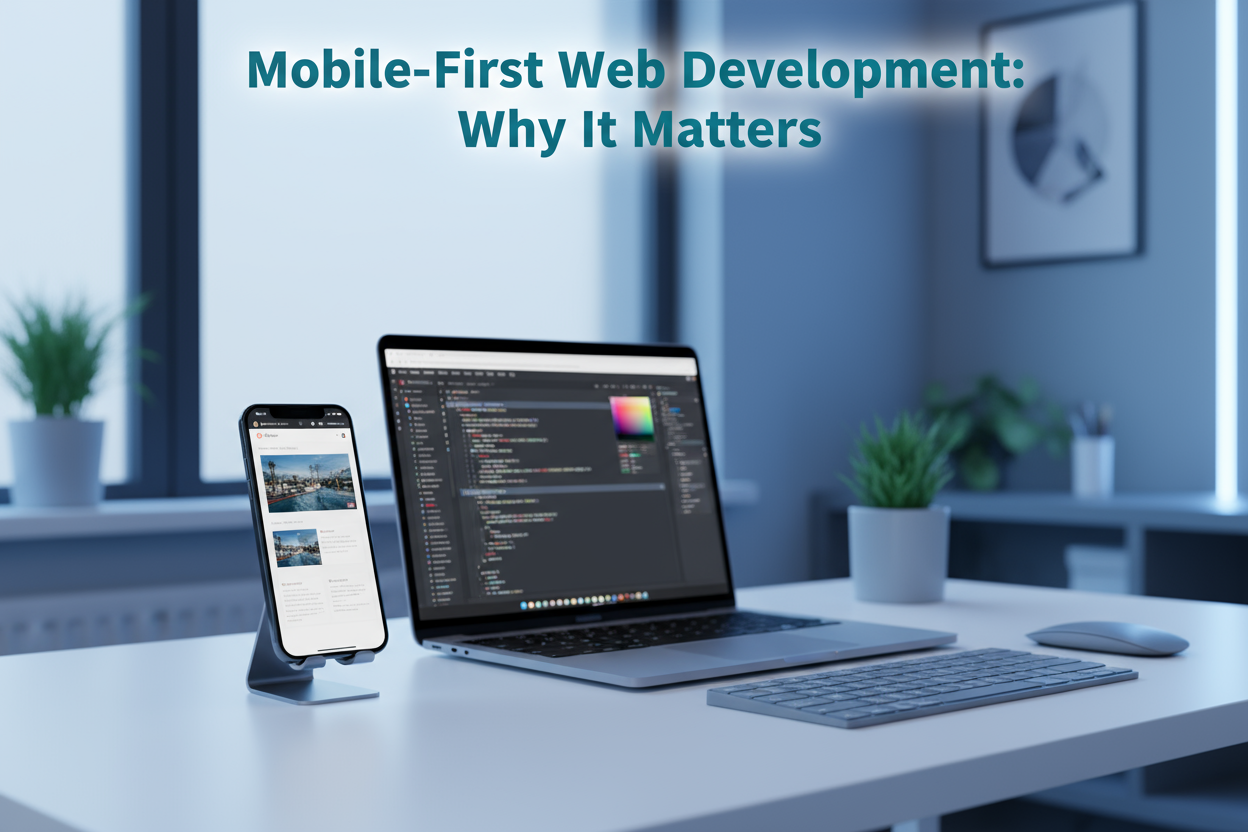In today’s digital world, mobile-first web development is not just a design trend—it’s an essential strategy for success. As smartphones and tablets continue to dominate online traffic, building websites optimized for mobile users has become a fundamental necessity for businesses aiming to stay competitive and visible in search results.
A mobile-first approach ensures your website is fast, responsive, and user-friendly across all devices, leading to better engagement, improved SEO rankings, and higher conversion rates.
What Is Mobile-First Web Development?
Mobile-first web development is a design philosophy that prioritizes the mobile user experience from the start. Instead of designing for desktops and later adjusting for smaller screens, developers begin with mobile layouts and then progressively enhance them for larger devices such as tablets and desktops.
This approach ensures that core content and functionality are accessible and efficient on all screen sizes. With mobile-first design, minimalism, speed, and usability become the foundation of every web experience.
Why Mobile-First Design Matters More Than Ever
In 2025, over 70% of all web traffic comes from mobile devices. Google has also switched to mobile-first indexing, meaning it primarily uses the mobile version of your website for indexing and ranking. This shift makes mobile optimization critical for search engine visibility.
A non-mobile-optimized site can lead to high bounce rates, poor user experiences, and lower rankings. Businesses that embrace mobile-first web development enjoy faster load times, better engagement, and improved SEO performance.
The SEO Advantages of Mobile-First Development
1. Google’s Mobile-First Indexing
Google now prioritizes the mobile version of your website when crawling and indexing content. If your mobile site is incomplete, slow, or poorly designed, your rankings will suffer—even on desktop searches. A responsive and mobile-optimized website is therefore vital for achieving strong organic visibility.
2. Faster Page Load Speeds
Speed is one of Google’s most important ranking factors. A mobile-first website typically uses lighter code, optimized images, and efficient layouts that load quickly on all devices. Faster websites lead to better user satisfaction and lower bounce rates, which signals quality to search engines.
3. Improved User Experience
User experience (UX) plays a significant role in SEO. A mobile-friendly interface ensures easy navigation, readable text, and accessible buttons—elements that make users stay longer and engage more. This, in turn, increases dwell time, a positive ranking signal.
4. Enhanced Core Web Vitals
Google’s Core Web Vitals—Largest Contentful Paint (LCP), First Input Delay (FID), and Cumulative Layout Shift (CLS)—focus on page speed, interactivity, and visual stability. A mobile-first design naturally improves these metrics, leading to higher SEO rankings and a smoother browsing experience.
Key Principles of Mobile-First Web Design
1. Responsive Layouts
A responsive design adapts to any screen size automatically. Using CSS media queries, grids, and flexible images ensures that your website looks and functions perfectly on smartphones, tablets, and desktops.
2. Prioritizing Content
On small screens, less is more. A mobile-first design focuses on essential content—clear headings, concise text, and actionable elements. This makes it easier for users to find what they’re looking for quickly.
3. Simplified Navigation
Complex menus and cluttered layouts can frustrate mobile users. Instead, hamburger menus, sticky navigation bars, and simple hierarchies improve accessibility and reduce friction in the browsing journey.
4. Optimized Images and Media
Large, uncompressed images slow down load times dramatically. Mobile-first development prioritizes image compression, lazy loading, and modern formats like WebP to enhance speed without sacrificing quality.
5. Touch-Friendly Elements
Buttons and links must be easily tappable without zooming or misclicking. Designing with finger-friendly spacing improves usability and accessibility, particularly for users browsing on small touchscreens.
Performance Optimization in Mobile-First Web Development
Performance optimization is at the heart of mobile-first design. Here’s how we achieve blazing-fast mobile experiences:
- Minifying CSS and JavaScript to reduce file size
- Using Content Delivery Networks (CDNs) for faster asset delivery
- Implementing browser caching to store static resources locally
- Deferring non-critical scripts for quicker first loads
- Applying Accelerated Mobile Pages (AMP) for instant-loading content
These techniques ensure that your website not only ranks higher but also retains users through superior performance.
How Mobile-First Design Boosts Conversions
A seamless mobile experience directly impacts conversion rates. Studies show that a 1-second delay in page load can reduce conversions by up to 20%. When users can navigate, read, and purchase effortlessly, they’re more likely to take action.
Mobile-first websites build trust through accessibility and speed, leading to increased customer satisfaction and repeat engagement.
The Role of Progressive Enhancement
Progressive enhancement complements mobile-first development by building a solid foundation first, then adding advanced features for capable devices. This ensures that every user, regardless of device or connection speed, experiences a functional and optimized website.
For instance, start with HTML content, then enhance styling using CSS, and finally add JavaScript interactivity. This layered approach guarantees compatibility and performance across all platforms.
Common Mistakes to Avoid in Mobile-First Web Development
Even experienced developers can fall into traps when adopting a mobile-first approach. Avoid these common mistakes:
- Overloading the mobile layout with too many features
- Ignoring touch gestures and mobile navigation patterns
- Using non-optimized fonts that reduce readability
- Neglecting testing across devices and browsers
- Failing to prioritize accessibility for all users
By addressing these pitfalls, you create a clean, fast, and user-friendly mobile experience that ranks and converts.
The Future of Mobile-First Web Development
As emerging technologies like 5G, AI, and voice search evolve, mobile-first design will continue to be the cornerstone of digital strategy. Websites will increasingly integrate micro-interactions, AI chatbots, and personalized experiences that adapt to user behavior in real time.
Businesses that adopt mobile-first web development now are not only staying relevant but also preparing for the next generation of digital users.
Conclusion
In an era where mobile dominates the digital landscape, mobile-first web development is no longer optional—it’s a requirement for visibility, engagement, and growth. By focusing on speed, usability, and responsive design, businesses can enhance their SEO performance, deliver exceptional user experiences, and gain a decisive edge in the competitive online marketplace.
Mobile-first design doesn’t just future-proof your website—it ensures you stay ahead of the curve in every digital evolution.







